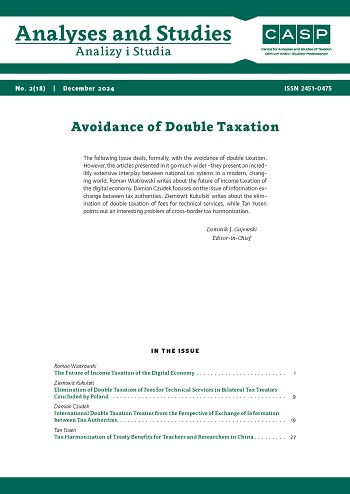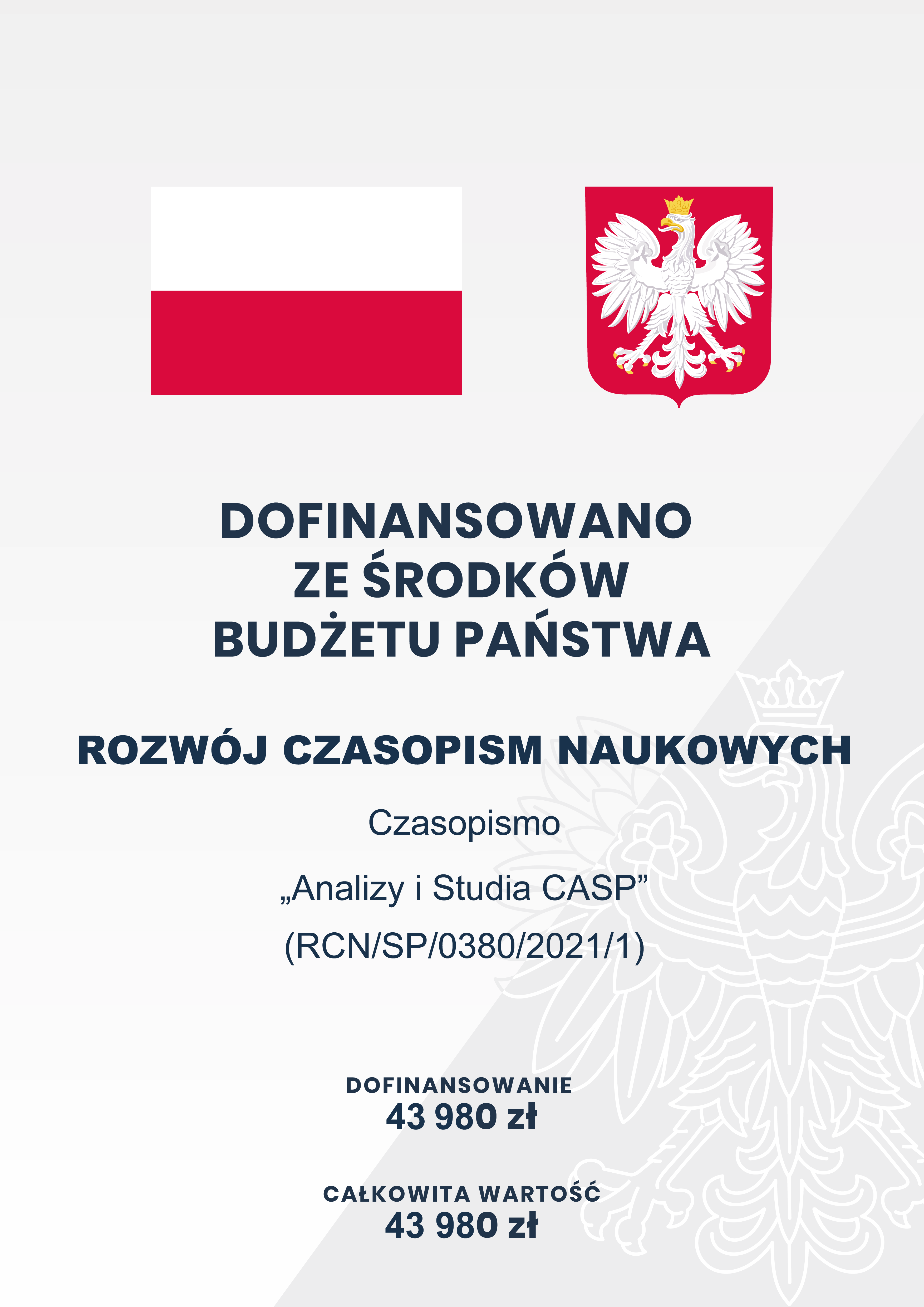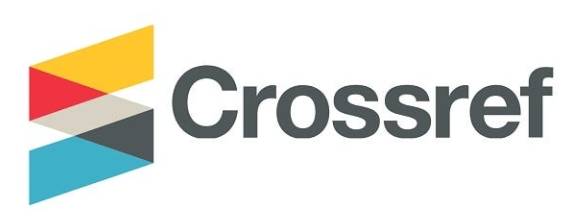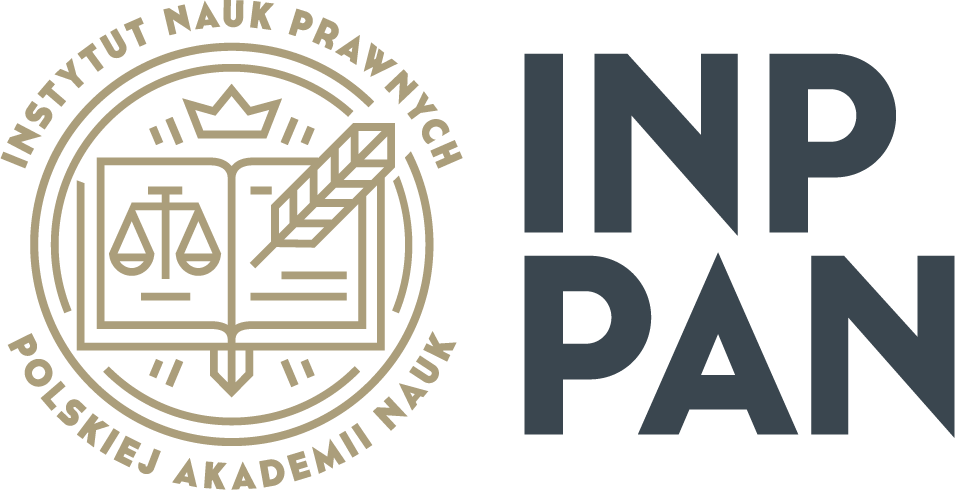Przyszłość opodatkowania podatkami dochodowymi gospodarki cyfrowej
DOI:
https://doi.org/10.33119/ASCASP.2024.2.1Słowa kluczowe:
digital economy, profit allocation, Pillar One, DSTAbstrakt
Pomimo szybko następujących zmian technologicznych od niemal stu lat niezmienione pozostają międzynarodowe zasady alokacji zysków. Zasada, że alokacja zysków jest zwią- zana z położeniem zakładu, wynika z międzynarodowych przepisów dotyczących opodat- kowania przedsiębiorstw i związana jest z tzw. zasadą stałego zakładu (permanent estab- lishment), która ma na celu przypisanie dochodów przedsiębiorstwa do kraju, w którym faktycznie prowadzi działalność gospodarczą. W artykule autor przedstawia, jakie zmiany w międzynarodowym prawie podatkowym możliwe są w odniesieniu do alokacji zysków w gospodarce cyfrowej.
Bibliografia
BEPS Action 1 (2015), https://www.oecd-ilibrary.org/docserver/9789264241046-en.pdf?expires=1727540890&id=id&accname=guest&checksum=C56E8905C6B7B641DA4B55367193B8A1_EN.pdf (accessed: 30.09.2024).
Congressional Research Service (n.d.). The OECD/G20 Pillar 1 and Digital Services Taxes: A Comparison, https://crsreports.congress.gov/product/pdf/R/R47988 (accessed: 21.09.2024).
Devereux, M., Simmler, M. (2021, July). Who Will Pay Amount A? EconPol Policy Brief, 36(5), July, https://www.econpol.eu/sites/default/files/202107/EconPol_Policy_Brief_36_Who_Will_Pay_Amount_A_0.pdf (accessed: 29.09.2024).
Gajewski, D. (2018). International tax law regulations and the implementation of BEPS measures. BAS Studies, Bureau of Parliamentary Analysis, 2(54).
Hongler, P., Pistone, P. (2015). Blueprints for a New PE Nexus to Tax Business Income in the Era of the Digital Economy. WU International Taxation Research Paper Series, 15.
Majdowski, F. (2024). News from Brussels. Tax Review, 4. Mirembe, R. (2023). Pillar one: there is an agreement! Who benefits from it? CASP Analyses and Studies, 1(15), p. 50.
Morawska, K. (2022). The impact of the digital revolution on international rules for the distribution of taxing rights. State and Local Government Budget Law, 3(10).
Mozgiel-Wiecha, K. (2021). A new framework for digital tax. Annales Universitatis Mariae Curie-Skłodowska, sectio G (Ius), 68(2).
OECD (n.d.). The Multilateral Convention to Implement Amount A of Pillar One (the MLC), https://www.oecd.org/tax/beps/multilateral-convention-to-implementamount-
a-of-pillar-one.htm (accessed: 30.09.2024).
OECD/G20 Base Erosion and Profit Shifting Project (2020), https://www.oecd.org/content/dam/oecd/en/topics/policy-issues/beps/statement-by-theoecd-g20-inclusive-framework-on-beps-january-2020.pdf (accessed: 28.09. 2024).
Secretariat Proposal for a “Unified Approach” under Pillar One, https://web-archive.oecd.org/2019-10-10/532365-public-consultation-document-secretariat-proposal-unified-approach-pillar-one.pdf accessed: 28.09. 2024).
O’Reilly, P. et al. (2023). Pillar one economic impact assessment update: the OECD/G20 project on tax base erosion and profit shifting. OECD Taxation Working Papers, 66.
RSM (2023), https://rsmus.com/insights/services/business-tax/india-has-significantly-expanded-its-equalization-levy.html (accessed: 22.09. 2024).
Sábo, J. (2020). Taxation of digital services from international tax law perspective. Financial Raw Review, 20(4).
Tapscott, D. (1998). The Digital Economy. Hopes and anxieties of the Era of Systemic Consciousness. Warsaw: Business Press.
Wieśniak-Wiśniewska, A., Czerwiński, M. (2016). The world of taxation after the BEPS project and its impact on Polish taxpayers. Tax Review, (6).
Tax Challenges Arising from Digitalisation – Interim Report (2018), https://www.oecd.org/en/publications/tax-challenges-arising-from-digitalisation-interimreport_ 9789264293083-en.html (accessed: 29.09. 2024).
The Government of Canada (n.d.), https://www.canada.ca/en/services/taxes/excise-taxes-duties-and-levies/digital-services-tax.html (accessed: 29.09.2024).
Normative acts:
Balancing the two pillars (2024), https://www.europarl.europa.eu/RegData/etudes/BRIE/2024/762346/EPRS_BRI(2024)762346_EN.pdf (accessed: 30.09.2024).
Proposal for a COUNCIL DIRECTIVE laying down rules on the taxation of legal persons with a significant digital presence; COM/2018/0147 final – 2018/072 (CNS), https://eur-lex.europa.eu/legal-content/PL/ALL/?uri=COM:2018:0147:FIN (accessed: 16.09. 2024).
Proposal for a COUNCIL DIRECTIVE on a common system of digital services tax levied on revenue deriving from the supply of certain digital services; COM/2018/0148 final – 2018/073 (CNS), https://eur-lex.europa.eu/legal-content/PL/ALL/?uri=COM:2018:0148:FIN (accessed:
09. 2024).
Statement on a Two-Pillar Solution to Address the Tax Challenges Arising from the Digitalisation of the Economy (2021), https://www.oecd.org/content/dam/oecd/ en/topics/policy-issues/beps/statement-on-a-twopillar-solution-to-address-the-tax-challenges-arisingfrom-the-digitalisation-of-the-economy-october-2021.pdf (accessed: 30.09. 2024).
Pobrania
Opublikowane
Jak cytować
Numer
Dział
Licencja

Utwór dostępny jest na licencji Creative Commons Uznanie autorstwa – Użycie niekomercyjne 4.0 Międzynarodowe.
Autor (Autorzy) artykułu oświadcza, że przesłane opracowanie nie narusza praw autorskich osób trzecich. Wyraża zgodę na poddanie artykułu procedurze recenzji oraz dokonanie zmian redakcyjnych. Przenosi nieodpłatnie na Oficynę Wydawniczą SGH autorskie prawa majątkowe do utworu na polach eksploatacji wymienionych w art. 50 Ustawy z dnia 4 lutego 1994 r. o prawie autorskim i prawach pokrewnych – pod warunkiem, że praca została zaakceptowana do publikacji i opublikowana.
Oficyna Wydawnicza SGH posiada autorskie prawa majątkowe do wszystkich treści czasopisma. Zamieszczenie tekstu artykuły w repozytorium, na stronie domowej autora lub na innej stronie jest dozwolone o ile nie wiąże się z pozyskiwaniem korzyści majątkowych, a tekst wyposażony będzie w informacje źródłowe (w tym również tytuł, rok, numer i adres internetowy czasopisma).
Osoby zainteresowane komercyjnym wykorzystaniem zawartości czasopisma proszone są o kontakt z Redakcją.
Autor zgadza się na dalsze udostępnianie pracy wg wymagań licencji CC-BY-NC























